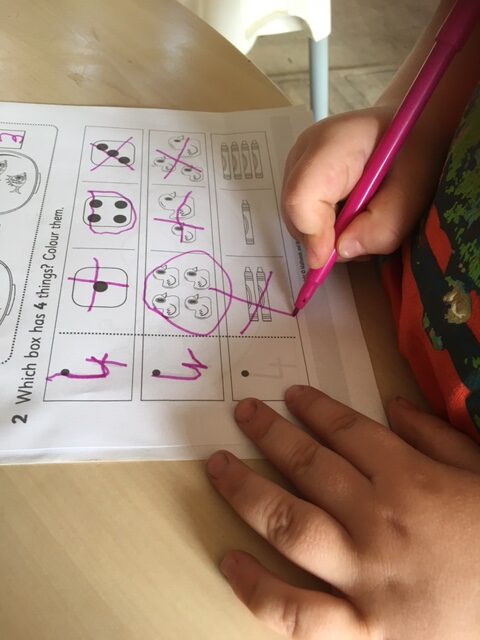When we talk about home education, we talk about how the education can be tailored to the child but what does that actually mean?!
Well, it means that..
1) You set the pace: There’s no race to the finish line. It’s perfectly okay for home learners to study over a longer (or shorter) period of time than school would allocate.
Home education allows you to remove the stress around learning. Nobody knows your child more than you – if they’re ready and able to learn, encourage them; if they’re struggling, take the pressure off. Homeschooling your children allows you to moderate or ramp up their schooling to accommodate their needs. It’s perfectly ok to focus only on one or two subjects at a time; it’s also ok to push a child who enjoys learning.
Not all children are ready to learn at five, some can multiply double digits at three. Neither is right or wrong, however, many studies – primarily looking at data from Scandinavian & European countries with later school-starting ages than the UK – show that by age 11, there is no difference in academic achievement between children who begin formal literacy & numeracy education at different ages. Conversely, studies also show that children who have a delayed start to formal education enjoy learning more into their teen years.*
Home education allows you and your child to schedule GCSEs/alternatives in a time frame that will support your child to attain the best results they’re capable of. GCSEs do not all need to be taken during one three-week block as in schools, they don’t need to be sat at 16, and they are not the defining factor of a successful education. Remember that home educating allows YOU to define what qualifies as an education – tailoring it to your child means thinking outside of the 4 -16 + GCSEs route of schools and working out what education will best suit your child.
*This short article summarises the findings.
2) You set the curriculum: The subjects and topics your child studies can be tailored to meet their individual needs and interests.
3) Homeschoolers can study in a way that supports their intuitive learning style.
For some that might be online schooling options that keep them on track via assessment deadlines, for another child, parent-teacher-led, guided learning might provide the support they need to stay focused. A different child might feel more motivated by the adaptive learning progression of online courses; other homeschoolers might respond best to an autonomous style of learning (using, for example, weekly folders and a flexible homeschool timetable).
4) You set the rules! It’s perfectly ok to allow homeschoolers to come to class in pyjamas if that’s how they feel most relaxed, it’s ok to offer snacks during lessons and it’s ok to make any accommodations your home learner might need – no matter how far from school that looks from the outside.
There is no one way to homeschool, and no one way to learn.
(Read about creating an environment for learning and accommodating different needs here.)
Tailoring education to the child means supporting their studies with methods of learning that help them actually learn – a child who despises worksheets and completes them only reluctantly will learn less from completing those worksheets than from demonstrating their knowledge via a conversation, an essay or a project-based study of the topic.
Tailoring an education to the child means focusing on what’s being learnt not the method. Take these examples of our pre-schooler completing worksheets as an example.
The worksheets ask him to colour the correct answers. He refuses, preferring instead to circle the right answer and mark with a cross the incorrect ones.


According to the worksheet instructions, he is getting all answers wrong – but is he?
The purpose of the worksheet is to practice number recognition – he’s doing that. He is meeting the learning objectives of the exercise.
Following instructions is a sub-lesson within the activity, and yes, learning to follow instructions is an important aspect of learning, but that doesn’t mean his schoolwork here is wrong. Were I to force him to follow the instructions here, he might be resistant to the lesson itself. As it is, his focus is the numbers, recording the answers in a way that makes sense to his brain.
In a school environment, teachers have to ensure that both aspects of the worksheet are learnt by the pupil – the maths and correctly filling in the sheet. In home-ed, it’s perfectly ok to praise the maths and teach the skill/behaviour of following instructions via different activities, such as building with Lego/colour by numbers etc.
Tailoring an education means making accommodations for individual students, creating an environment that encourages learning, and using a definition of education that resonates with you, as a parent-educator, to help your unique child thrive.
For younger homeschoolers, that means (as above) allowing them to take the lead. The principles of Montessori schooling (self-led learning, exploration, guided environments) work wonders with children in primary school. Little kids are figuring out their world! Who am I? What can I do? What do I like to do? Giving them the freedom to explore, giving them autonomy by allowing them to choose activities (and how those activities manifest), and encouraging them to explore within a curated learning environment, naturally tailors their learning experience.
Older homeschoolers thrive in such environments too and an unschooling approach to home education is in essence an extension of the Montessori approach, but while unschooling can be great for the learner, it doesn’t always reassure the parent that their child is learning what they ‘need’ to be learning and it doesn’t work for every child.
Tailoring an education for older homeschoolers can mean mixing and matching different styles of learning: Parent-led lessons, online courses, self-led study. It can mean combining subjects the homeschooler is interested in with academic goal-posts they need to meet – asking them to practise essay writing via a topic that excites them, even if that topic seems ‘non-academic’ at first glance, like a video game or the history of the yo-yo.
Homeschoolers thrive when they understand why they’re learning, feel in control of their learning environment and are engaged in the content they’re studying – the more involved they are in the curation of the curriculum, the more engaged they’ll be in the lessons. Why wait until college to ask them what they’d like to study? Why not start giving them the freedom to shape their learning pathway while they’re still learning how to learn?
Tailoring the curriculum of their homeschool to follow their interests can support academic strengths and boost their confidence & ability to learn academic subjects and skills that don’t come naturally. Especially as homeschoolers get older, ensuring they feel connected to and engaged with their studies is the easiest way to help them maintain the natural curiosity towards learning new things that 99.9% of children innately possess.
